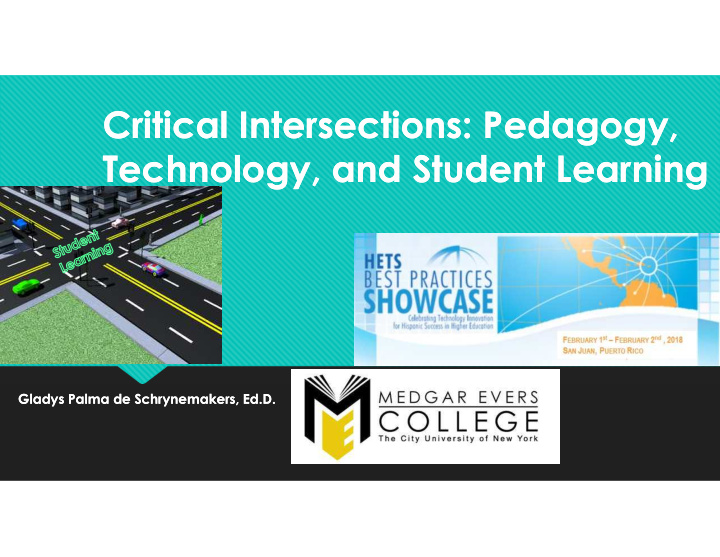



Critical Intersections: Pedagogy, Critical Intersections: Pedagogy, Technology, and Student Learning Technology, and Student Learning Gladys Palma de Schrynemakers, Ed.D. Gladys Palma de Schrynemakers, Ed.D.
Things that Make You Go Things that Make You Go Hmmmmmmmmmm… Hmmmmmmmmmm… Jacob’s Shell Women’s Volleyball Team
What is your Technological Age? What is your Technological Age? • Reads the newspaper, listen to radio, and watch TV to get news • Watches Cable • Post Power Points on-line • Provide tests on-line • Just uses cellphone to make calls and text
21 St Century Technological Age 21 St Century Technological Age - Participates in video conferencing -Obtains news from Social Network and self-scribed news alerts like Huffington -Creates own videos(vines) to post on educational and social media sites -Has a digital footprint in social media and professional media -Publishes in Digital Texts http://scalar.usc.edu/works/the-art- of-academic-peer-reviewing/case- 5-gladys-palma-de-schrynemakers
Teaching Today Teaching Today
Disruptive Technology? Disruptive Technology? “What we’re labeling as ‘distraction,’ some see as a failure of adults to see how these kids process information,” Ms. Purcell said. “They’re not saying distraction is good but that the label of ‘distraction’ is a judgment of this generation.” Kristen Purcell, the associate director for research at Pew
So Why Did a Social Scientist and lapse Biology GEEK become So Why Did a Social Scientist and lapse Biology GEEK become Interested in Teaching with Technology? Interested in Teaching with Technology?
College Readiness and Academic College Readiness and Academic Engagement Engagement (Conley, 2007 p. 6)
Construct Knowledge Construct Knowledge Constructivism calls for approaches to learning in environments where learners actively participate in ways that are intended to aid them in the construction of their own knowledge, rather than regurgitating the teachers’ interpretation of the world. Learners are actively engaged in interpreting the external world, reflecting on their interpretations, participating and interact with the surrounding environment in order to create their own construct of the subject/topic. (Jonassen, 1998)
Digital Experiential Learning 1. Provide students with the experience to construct their own knowledge 2. Provide experience in and appreciation for multiple perspectives 3. Embed learning in realistic and relevant context 4. Encourage ownership and voice in the learning process 5. Embed learning in social experience 6. Encourage the use of multiple modes of representation 7. Encourage self-awareness in the knowledge construction process (Honebein,1996)
An example of a Digital Learning An example of a Digital Learning Community Community The first objective of Project Quest was to create a heuristic educational science program for undergraduates that optimizes their skills in the life sciences and assists them in finding careers in the STEM fields, and the second was to create a community of undergraduate science learners. The learning community was established, in part, through the creation of weekly Academic Seminars—scheduled once a week for ten weeks during each academic semester—that were designed to help participating students hone their skills in literacy, technology, critical thinking, and scientific competencies.
•QUEST Scholars will gain an instructive overview of the fundamental principles and subjects of entry-level biology, chemistry, and mathematics courses. •QUEST Scholars will gain knowledge and experiences in basic methodologies in science used to conduct scientific research, including instruction in the use of instrumentation and strategies and practices to improve quantitative analytical skills. •QUEST Scholars will develop critical thinking and communication skills, both oral and written, for purpose of conveying scientific information to both professional scientists and the lay public. •QUEST Scholars will develop intellectual independence, scientific literacy, and an appreciation for the connections between biological science and society.
USE OF DIGITAL MEDIA TO INTRODUCE TOPICS USE OF DIGITAL MEDIA TO INTRODUCE TOPICS
Historical Scientific Articles Historical Scientific Articles Digital Prompt Galileo challenged an existing scientific model within a specific political climate. The state used this model to justify its own authority. How did Galileo's theory threaten the established religious, scientific, social and political order? What was the crucial difference between Copernicus' and Galileo's model? The Galileo Affair In arguing that the earth circles the sun Galileo adopted a mode of reasoning that led not only to his prosecution by the church but also to the new scientific methodology of hypothesis testing By Owen Gingerich
Plato’s Cave Plato’s Cave
Academic Seminars Academic Seminars
QUESTIONS QUESTIONS
References References Conley, D.T. (2007). Redefining college readiness. Eugene, OR: Educational Policy Improvement Center. Honebein, P. (1996). Seven goals for the designing of constructivist learning environments. In Wilson, B.(Ed.) Constructivist learning environments(pp. 11-24). Educational Technology Publication Khanna, P. & A. (2012). Hybrid Reality: Thriving in the Emerging Human-Technology Civilization. TED Books, Book 15. Jonassen, D. H. (1998). Computers as mindtools for engaging learners in critical thinking. TechTrends , v43 n2 p24-32.
Recommend
More recommend